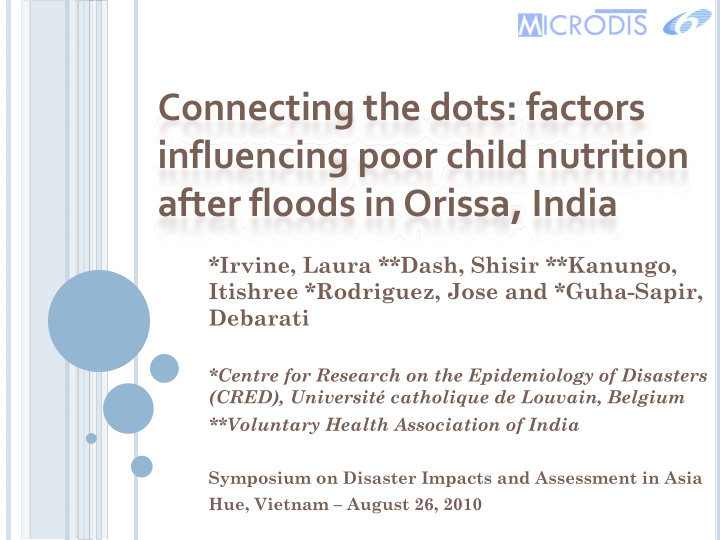



Connecting the dots: factors influencing poor child nutrition after floods in Orissa, India *Irvine, Laura **Dash, Shisir **Kanungo, Itishree *Rodriguez, Jose and *Guha-Sapir, Debarati *Centre for Research on the Epidemiology of Disasters (CRED), Université catholique de Louvain, Belgium **Voluntary Health Association of India Symposium on Disaster Impacts and Assessment in Asia Hue, Vietnam – August 26, 2010
B ACKGROUND : MICRODIS P ROJECT � 4 year project funded by the European Commission’s 6 th Framework Program � Integrated social, health and economic impacts of disasters in Asia and Europe � 19 partners from academic institutions and grassroots organizations � 10 field sites in Philippines (2), Vietnam (2), India (2), Indonesia, United Kingdom (2) and Italy � Training and capacity building, information dissemination, scientific papers, website, etc. www.microdis-eu.be
S TUDY S ITE : J AGATSINGPUR , O RISSA , I NDIA � Seasonal floods, affected by cyclones � Area: 1914.6 Sq. Km � Population: 11,39,126 � MICRODIS event in focus: 2008 severe flooding
O BJECTIVE OF S TUDY � Find more in-depth and descriptive information about factors influencing poor child nutrition in flooded and non flooded communities. � Nutrition: perception, reality and awareness � Water and sanitation � ICDS centre experience � SHGs and Micro-Credit � Access to health care facilities
M ETHODOLOGY � Sample area for quantitative study used to chose groups for qualitative study (of 4 blocks, 2 per block) � 9 Focus Group Discussions (5 flooded, 4 non- flooded) � Women, SHG members, ICDS workers, mothers, 1 group of fathers � Semi-structured questions for each group � Participatory activities (community mapping, decision table, food pyramid diagram, seasonal vegetable yield patterns) � 1 facilitator, 1 observer, 1 note taker, video � 10-12 participants per group
R ESULTS : NUTRITION PERCEPTION & REALITY � Nutrition poor in all but 1 village � Negative impacts on health and nutrition level in children in post-flood period reported by all � Lack of awareness of what malnutrition is and what foods are nutritious � Sell before consume = poor quality of foods � Washed out crops � Skinny vs fat conclusion
R ESULTS : W ATER AND S ANITATION � Water sources contaminated (iron and salt), especially in flood � No treatment of water � Water storage a concern � No hand washing, no soap � Bathing (not thorough, in contaminated water, privacy) � Awareness good but no action � Floods amplifying these sanitation concerns � Open defecation � Cause and transmission routes of environmental- related diseases*
Water Engineering and Development Centre (c) Rod Shaw
R ESULTS : I NTEGRATED C HILD D EVELOPMENT S ERVICE S CHEME (ICDS) CENTER EXPERIENCES � Poor quality and quantity of food rations � Dry rations given, cooked food unsatisfactory � Poor knowledge and training for scientific thresholds for malnutrition and methods � Lack of equipment and know-how to use it, inappropriate equipment � Positive programs for awareness and community involvement at different levels (hand washing, stick figure attendance, etc.)
R ESULTS : SHG S AND MICRO - CREDIT � Community members who deal with micro-credit � Present in almost every village � Mainly credit for social events, education, construction, not for nutrition � Support service to individuals, even the most poor (with guarantee from other) � SHGs help with the ICDS centers sometimes, and could help with credit for medical expenses
R ESULTS : ACCESS TO HEALTH CARE FACILITIES � Access is a nagging problem – even without floods � Access to health care facilities disrupted for flood affected areas: centres closed (flooded or not able to access), immunizations and rations not available � Some good rotation or mobile help during floods ALL GROUPS � Wages vs Health Care � Neglecting non-obvious health problems
D ISCUSSION AND C ONCLUSIONS � Child nutrition is poor, and could even be underestimated based on reported perceptions � Public health awareness can improve, but the bigger problem lies in implementation of already known good practices � Connecting sanitation practices with other public health concerns as a root cause for many � Education, awareness, training for infrastructure � ICDS centers – quality and quantity of food, education programs, ensuring access during floods
D ISCUSSION AND C ONCLUSIONS � Economic disparity as an intertwined cause of many child health issues � Crops washed away � Sell then consume low quality items � Cant afford healthier foods � Preparation lacking taste � Wages vs. health care � Gender aspects also could influence nutrition in our sample � Order of taking food, decision-making power, social misconceptions about eating when pregnant, etc.
R ECOMMENDATIONS � Cross check with quantitative data � Learn from programs that are working (awareness, communication strategy, SHG loans, rotation of ICDS services) � SHGs can be mobilized to combat malnutrition � Re-evaluate the quality and quantity of food rations and functioning of the ICDS centres
R ECOMMENDATIONS � Education and awareness programs for nutrition and sanitation – water use and open defecation � Looking at the root behaviour � Teaching mothers nutritious value of local goods, shaking the skinny-fat perception of malnutrition � Encourage continued SHG support for economic limitations leading to lack of health care or proper nutrition
T HANK YOU FOR YOUR ATTENTION www.microdis-eu.be Information given in this presentation reflects the authors' views only. The Community is not liable for any use that may be made of the information contained therein.
Recommend
More recommend